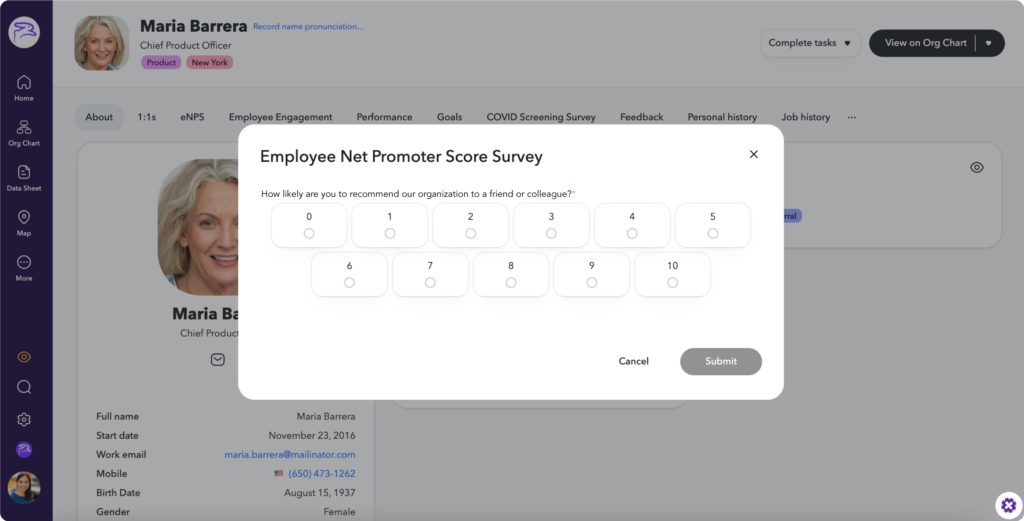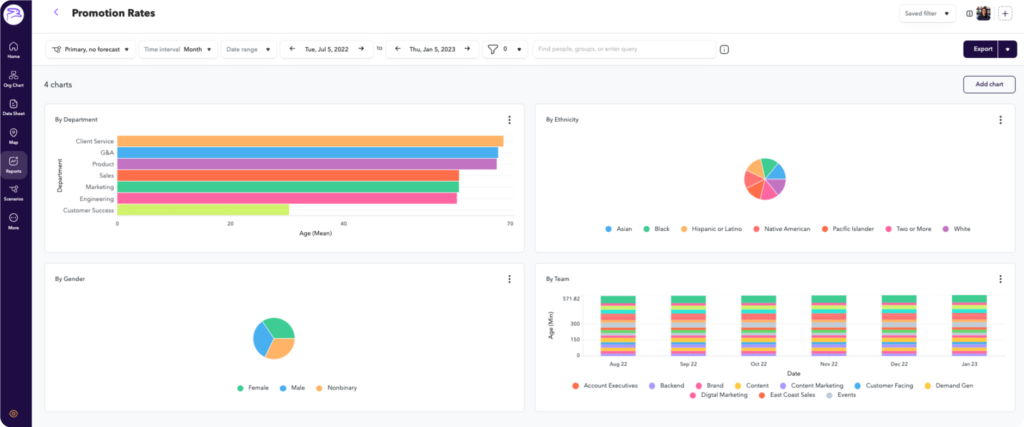
Welcome to the world of HR, where one of our biggest challenges is trying to reduce turnover. You probably know firsthand the pains of high employee attrition rates: the time-consuming nature of training new hires, lagging team productivity as priorities shift, and mitigating damage to company morale.
That’s why it’s so important to minimize turnover as much as possible. Luckily, we’ve compiled a list of people metrics for you to track to help reduce voluntary turnover, all while keeping your people happy and engaged.
In HR, turnover – or employee attrition – is the term used to reference when employees leave a workplace. There can be voluntary turnover (when people pursue a new opportunity or retire) or involuntary turnover (which includes lay-offs and termination).
Regardless of the cause, high turnover rates are a major concern for businesses because:
Like other HR initiatives, employee turnover is something that you can (and should) minimize using people metrics and data.
If you’re ready to tackle turnover, calculating your company’s turnover rate is a great place to start. This popular people metric simply refers to the number of employees that leave an organization in a given period of time. Using the ratio below, with either monthly or annual numbers, you can better understand the rate at which your employees move through the employee lifecycle:

Your answer to this equation serves as the first step to minimize risks of turnover down the line. If your turnover rate is higher than you’d like, you’ll want to use other people metrics to help reduce it.
You should always work towards reducing your voluntary turnover rate, as high attrition is usually reflective of internal problems or poor company culture. And as a part of that process, it’s important to know what is considered a high rate (and what’s just normal) when it comes to your people metrics.
Unfortunately there’s not a clear-cut number, since employee attrition rates ebb and flow (hello, Great Resignation). But you can collect and track data to know where your own metrics stand. Routinely ask the following:
Measuring key contributors to voluntary turnover – such as employee engagement, professional development opportunities, and productivity – arms you with the holistic insights needed to create an environment in which people want to stay.
Employee engagement has a large hand in turnover and attrition. In fact, Gallup reports companies that score in the top 20% of engagement, where employees are challenged and motivated to come to work, have 59% less employee turnover than other businesses where engagement isn’t a priority.
While they may seem subjective, people metrics like eNPS rate exist to help quantify your employee experience.

ChartHop’s robust custom surveys allow you to create and distribute eNPS surveys to your employees.
Use the surveying tool employee net promoter score (eNPS) to collect feedback from employees. Ask employees to rank their experiences on a sliding scale from 0-10 around company culture, brand mission and values, career pathing, and managerial support. Then, divide responses into the following groups:
From there, you can plug-in your results into the formula to calculate eNPS Rate:

Using your eNPS rate in conjunction with written feedback provides a comprehensive understanding of engagement. These insights allow you to examine initiatives more granularly and address specific issues that might be directly affecting your turnover rate.
When collected, measured, and shared in one place – such as a people operations platform – eNPS rates enable org-wide transparency into your strengths and weaknesses, fueling everyone to address engagement issues and create a culture that supports their professional goals.
Looking for other methods to measure and address employee engagement?
Opportunities for growth and promotions motivate people to stay. Yet, 43% of employees report leaving their jobs due to a lack of clear career pathing.
One powerful people metric that can aid in reducing turnover is promotion rate. This metric measures the percentage of employees promoted in a period of time, enabling you to see how your professional development initiatives are performing.

When it comes to turnover reduction, your determined promotion rate allows you to:

Use your people operations platform to slice and dice your data to determine any strengths and weaknesses when it comes to your promotion rates.
Employee utilization rate is another strategic people metric for reducing your employee attrition rates. It’s used to calculate how much individuals are working in a given period of time to better gauge productivity.
In order to measure employee utilization rate, you need a time-tracking tool or employee feedback to know how many hours your employees spend on projects and tasks. Then, you can plug these numbers in to the formula below to determine your utilization rate:

Quantifying your employees’ bandwidth helps you avoid problems that can lead to turnover. So while you may be worried about employee burnout, your utilization rate could actually indicate your people are experiencing “bore-out,” which is when an employee doesn’t have enough to do.
For example, say Demitri spent 20 hours working on a project. His utilization rate for that 40-hour workweek is at 50%; he has 50% of his time to spare. If this rate continues, it indicates he might not be challenged on the job. Alternatively, Samantha spent 60 hours on a different project that week. She is working at a 150% utilization rate which, over long periods of time, is unsustainable and runs the risk of leaving her burnt out.
Knowing your employees’ bandwidth inside and out can aid in resource planning and task allocation to keep everyone working at reasonable rates and ultimately mitigate the risk of turnover.
No matter how your company changes and grows, tackling turnover should always be a top priority. The cost of turnover adds up, so it’s important to recognize the red flags and strategize ahead of time to prevent attrition before it happens.
Luckily, people metrics can help. Examining contributors to your employee attrition rates, like engagement, promotion rates, and utilization rates, can help you get strategic in ensuring tenure. And when you analyze these metrics in a people operations platform, you’ll have the holistic insights to create a data-driven employee retention plan that works for you.
Sign up for a free demo today.